Mad Hedge Biotech & Healthcare Letter
October 20, 2020
Fiat Lux
FEATURED TRADE:
THE MOST FAMOUS CANCER STOCK YOU’VE NEVER HEARD OF
(TRIL), (NVAX), (PFE), (IMMU), (SHOP), (GILD), (ABBV)

Mad Hedge Biotech & Healthcare Letter
October 20, 2020
Fiat Lux
FEATURED TRADE:
THE MOST FAMOUS CANCER STOCK YOU’VE NEVER HEARD OF
(TRIL), (NVAX), (PFE), (IMMU), (SHOP), (GILD), (ABBV)

Biotechnology stocks have proven time and time again to be excellent growth vehicles for risk-tolerant investors.
Underscoring this claim are companies like COVID-19 vaccine frontrunner Novavax (NVAX), which generated jaw-dropping returns on capital for their investors within an impressively short period.
Now, another biotechnology stock is showing telltale signs of following their footsteps: Trillium Therapeutics (TRIL).
Trillium’s story is a familiar one in the biotechnology industry.
Trading only in the penny stock range back in 2019, the company’s share price practically quadrupled since the start of 2020.
Taking into consideration that this meteoric rise actually happened while COVID-19 was blasting the world to smithereens, it’s hardly surprising that this news didn’t receive much media attention.
Trillium’s shares are currently up by an astounding 1,260% -- and the company still has so much room to grow from here.
For context, Trillium had a market capitalization of $7 million in November 2019. This number skyrocketed to $1.3 billion since its shift to cancer technology.
Although a lot of factors came into play, the key turning point for Trillium was when the company decided to go all-in on its cancer programs.
Ultimately, Trillium’s goal is to challenge chemotherapy.
The move to shutter its lead programs on tumor treatments and instead focus on developing cancer-fighting technology was the gamble of a lifetime for the company.
This gutsy move impressed investors, and Trillium was never the same since then.
Today, Trillium is the No. 1 stock on Canada’s S&P/TSX Composite Index, overtaking its previous leader e-commerce giant Shopify (SHOP) by almost 10-fold.
In the US, Trillium shares rank as the No. 4 best-performing company on the Nasdaq Composite Index.
While its epic stock market rally may have some investors feeling left out, all signs point to further gains in the future even for those who missed the initial boom.
Among the major capitalists of this biotechnology company is giant biopharmaceutical company and COVID-19 vaccine leader Pfizer (PFE), which invested $25 million in Trillium’s common stock.
While this equity stake may seem small in relation to Pfizer’s $212.16 billion market capitalization, this initial show of confidence is hailed as a prelude to an even bigger investment in the future.
So far, the most exciting cancer treatments in Trillium’s pipeline are TTI-621 and TTI-622.
These programs are in the same class of emerging cancer technologies, called CD47-based therapies, that prompted Gilead Sciences’ (GILD) $4.9 billion acquisition of Forty Seven, Inc. in April this year.
Aside from Gilead, AbbVie (ABBV) has also been reported to have invested a huge sum in this technology.
In simplest terms, CD47-based therapies can bypass the “don’t eat me signal” put up by some cancer cells in an effort to evade immune detection.
Thus far, both TTI-621 and TTI-622 have been showing promising results. Trillium recently announced that it will increase the dosage in these programs.
While Trillium leaders have not been specific in terms of being open to an acquisition, their recent statements indicate that they are not completely opposed to one.
It’s either that or a partnership with a company as big or even bigger than Pfizer.
As with all the biotechnology stocks, however, there will always be a risk.
For Trillium, the most evident one is competition.
While it’s true that the company has been recognized as the leader in the CD47 arena, more and more competitors are entering the immuno-oncology space.
Right now, the most obvious rival is Gilead, which added Immunomedics (IMMU) to its arsenal via a $21 billion acquisition deal.
Given the sheer amount of money that Gilead has been spending to practically corner the immuno-oncology market, it’s to be expected that more biopharmaceutical titans will enter the fray.
This is one of the reasons Trillium has been tagged as a prime candidate for a massive acquisition deal soon. So far, Pfizer is considered the most probable suitor.
Despite its astonishing performance this year, Trillium’s market capitalization still remains within the small-cap territory. That’s to be expected since its lead assets are still undergoing trials.
Considering that it is an early-stage biotechnology stock, Trillium does not have much in terms of income.
However, the company does have enough cash to last for a while. At the moment, it has $130 million cash.
With its total expenses of $38.8 million in 2019, I say this could offer the company more than three years of breathing room financially.
But it would be shocking if Trillium’s value won’t enter the large-cap territory (higher than $10 billion) if and when the company’s high-value assets reach the late-stage studies.
The fact that it’s also an attractive acquisition candidate offers incredible incentive to its investors.
Simply put, Trillium’s stock could get as much as 1,000% gain over the coming two to three years, making it an ideal investment for risk-tolerant investors.

Mad Hedge Biotech & Healthcare Letter
October 6, 2020
Fiat Lux
FEATURED TRADE:
(CAN THIS DIVIDEND KING BE THE NEXT VACCINE KING?)
(JNJ), (MRNA), (PFE), (BNTX), (AZN), (INO), (NVAX), (SNY)

One area that Johnson & Johnson (JNJ) has not been a leader in for the past years is vaccine development.
That could change soon however.
Among the healthcare companies racing to develop a COVID-19 vaccine these days, JNJ has been a heavy favorite to come up with the most potent candidate.
Although the company started its clinical trials two months after Moderna (MRNA) and the partners Pfizer (PFE) and BioNTech (BNTX) started theirs, JNJ might release results even earlier than November.
This is because JNJ’s vaccine candidate, called Ad26.COV2.S, worked quickly on the patients after only a single dose.
In comparison, Moderna and Pfizer’s candidates need a first dose and then, after a month, a second dose or a booster shot.
While it could take a month or two for Moderna and Pfizer’s vaccines to take effect, those given Ad26.COV2.S could be protected after two weeks.
Moderna and Pfizer both use messenger-RNA technology for their vaccines, while JNJ utilizes a hollowed-out virus to deliver the DNA instructions to the relevant cells to trigger a protein spike and provoke an immune response.
This is the same method the company used in its Ebola vaccine, which has been instrumental in the immunization programs in Africa.
Inasmuch as Ad26.COV2.S offers incredible potency compared to other candidates, there is one potential trade-off: our immune system might later on start to resist the drug.
However, JNJ is attempting to resolve this issue by developing a booster shot for future use.
Meanwhile, Moderna and Pfizer’s vaccine candidates could be given as many times as possible without that risk.
JNJ’s vaccine can also be distributed and stored without any special handling unlike its rivals, which require lower temperatures. This means that the vaccine can be delivered to even the less-developed facilities.
Other than eliminating the logistical problem of people failing to get a second shot of the vaccine, JNJ’s one-shot regimen can guarantee that governments can vaccinate 1 billion people annually.
Only a handful of the manufacturers can match that claim, offering JNJ an edge regardless of the seven-month head start of the other developers.
Apart from JNJ, Pfizer, and Moderna, more companies have started their late-stage vaccine trials. The list includes AstraZeneca (AZN), Inovio Pharmaceuticals (INO), Novavax (NVAX), and Sanofi (SNY).
Outside its COVID-19 programs, JNJ has been delivering solid results despite the ongoing crisis.
The company’s pharmaceutical division showed notable growth in the second quarter, with its immunology drugs leading the charge.
In terms of sales in this quarter, rheumatoid arthritis and Crohn’s disease drug Remicade raked in $935 million while severe rheumatoid, psoriatic, and ankylosing spondylitis injection Simponi brought in $526 million.
Meanwhile, psoriasis medicines Stelara and Tremfya generated an impressive $1.7 billion and $342 million, respectively.
JNJ is also expanding its portfolio to cover the biotechnology market. So far, one of its most telling moves is its $6.5 billion all-cash acquisition of Momental Pharmaceuticals.
Buoyed by these promising results, JNJ boosted its full-year revenue guidance for 2020 with operational sales estimated to reach somewhere between $81 billion and $82.5 billion.
JNJ has been widely known for its consumer products, but the truth is that the company’s forte is actually healthcare.
In 2019, JNJ’s pharmaceutical sector comprised nearly 50% while medical devices generated roughly one-third of the company's total sales. These figures may very well be the reason why this stock is gaining traction among retirees.
After all, healthcare is where the money lies – and JNJ is now the biggest healthcare conglomerate in the world.
In fact, the company serves over 1 billion patients on a daily basis and 12 of the products in its portfolio can easily generate $2 billion in sales annually.
The company’s cash flows have also been steadily increasing, setting off an impressive 58-year streak of consistent and consecutive dividend boost every year.
Needless to say, JNJ has been hailed the “Dividend King” in the healthcare sector for decades now.
Simply looking at JNJ profile, track record, and pipeline, it’s clear to see that buying and holding JNJ shares and reinvesting the dividends you receive along the way could give your portfolio a substantial boost.
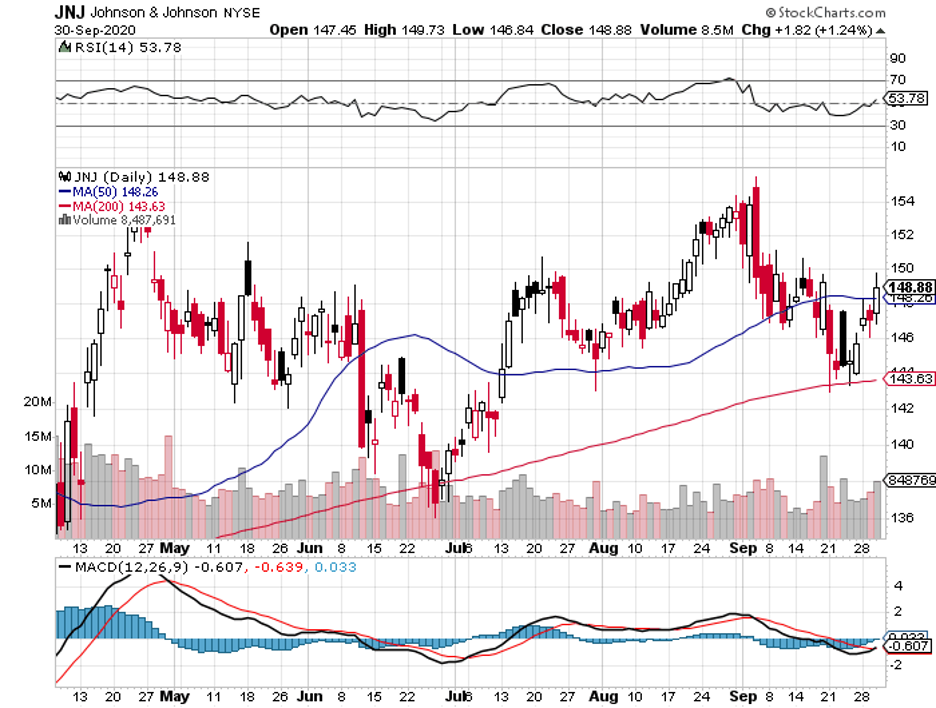
Mad Hedge Biotech & Healthcare Letter
August 25, 2020
Fiat Lux
Featured Trade:
(LET THE VACCINE PRICING WARS BEGIN)
(MRNA), (MRK), (PFE), (BNTX), (AZN), (JNJ), (NVAX), (SNY)

The COVID-19 vaccine race is winding down to its final lap, with at least seven candidates already undergoing Phase 3 trials.
Now, one question inevitably arises: How much will these vaccines cost?
Moderna (MRNA), one of the frontrunners in this race, revealed that its vaccine, mRNA-1273. will be priced somewhere between $32 and $37 for each dose.
The moment this pricing was announced, health advocates were up in arms to point out the high price of the vaccine especially with the funding Moderna received from the US government.
However, the company clarified that this would only apply to “small-volume” transactions.
According to Moderna, the pricing for their coronavirus vaccine should be viewed in two phases: the pandemic and the endemic periods.
During the pandemic period, the coronavirus vaccine would be given a price “well below” its actual value. The pricing will change and eventually be more in line “with other innovative commercial vaccines” when the crucial period passes.
For reference, flu shots are typically priced somewhere between $50 to $120 depending on the clinic while a single-dose HPV vaccine from companies like Merck (MRK) can cost up to $235.
Despite the clamor to further investigate this pricing scheme, Moderna sealed another deal with the US government worth $1.525 billion if the company succeeds in meeting its promised timeline.
This will translate to roughly $100 million doses.
It also stands to gain an additional $8.125 billion in follow-up doses plus the $300 million bonus if it can score an FDA approval by January 31, 2021.
Another frontrunner in this coronavirus vaccine race is Pfizer (PFE).
Among the healthcare and biotechnology companies working on a vaccine, Pfizer and its German partner BioNTech (BNTX) are reported to have the most lucrative contract with the federal government to date.
The company recently sealed a $1.95 billion deal for 100 million doses. This puts Pfizer’s coronavirus vaccine at roughly $20 per dose.
Both vaccine candidates from Pfizer and Moderna require two doses.
In comparison, Johnson & Johnson (JNJ) has a “one-and-done” vaccine candidate. That is, the Ad26.COV2-S showed potential that it could only require a single dose.
This is definitely a competitive edge as it will eventually be a cheaper and more convenient alternative to the two-dose vaccine offered by its competitors.
In terms of pricing, JNJ recently landed a $1 billion contract with the US government to deliver 100 million doses. This translates to $10 per dose.
However, AstraZeneca (AZN) appears to be the favored candidate by the US government.
In fact, recent reports suggest that the Trump administration is considering bypassing normal regulatory standards in the UK to fast track the delivery of the vaccine candidate to the US — all before election day.
What we know so far is that AstraZeneca, which is developing its vaccine in collaboration with the University of Oxford, signed a deal with the US government worth $1.2 billion.
This will amount to 300 million doses of their vaccine candidate, which puts the cost of each dose to roughly $4. At this price point, AstraZeneca offers the cheapest option.
Meanwhile, small-cap biotechnology company Novavax (NVAX) recently signed a similar deal with the government.
The Maryland-based company agreed to manufacture 100 million doses of its vaccine for $1.6 billion. This works out to approximately $16 per dose.
Next to Moderna, Novavax’s journey this year has been considered a “Cinderella story” by a lot of investors.
The company ended 2019 all banged up, with the biotechnology stock falling by almost 90%, thanks to its failed respiratory syncytial virus (RSV) vaccine candidate.
However, Novavax rose from the ashes following the encouraging results of its late-stage study for NanoFlu, another vaccine candidate.
By March 2020, Novavax’s flu vaccine released promising data that put NanoFlu in direct competition against Sanofi’s (SNY) flu vaccine Fluzone Quadrivalent.
Riding the momentum of their success with NanoFlu, Novavax joined the COVID-19 vaccine race with NVX‑CoV2373.
While companies like Pfizer, Moderna, JNJ, and AstraZeneca have been gaining media attention, an increasing number of health experts and analysts are claiming that Novavax’s candidate might just be the best in class.
Outside the companies under Trump’s Operation Warp Speed, China’s state-owned company, Sinopharm, also announced the pricing for its COVID-19 vaccine candidates.
The pricing is quite higher than those put forward by other vaccine developers, with the Beijing company quoting $145 for two doses.
Aside from China, Russia also has a vaccine candidate expected to be out in the market soon.
Vladimir Putin claims that Russia’s coronavirus vaccine candidate is similar to the one created by AstraZeneca and Oxford University.
No information has been given on either the results of the vaccine’s late-stage trials or its pricing.
To date, the World Health Organization (WHO) has recorded 7 vaccine candidates undergoing Phase 3 clinical trials, while there are 15 more going through Phase 2 expanded safety trials.
An additional 25 candidates are currently under Phase 1 small-scale trials plus another 138 pre-clinical candidates slated for human trials soon.
The development and success of at least one coronavirus would undoubtedly reverse the economic and financial damage brought by the pandemic. Hopefully, that time will come soon.
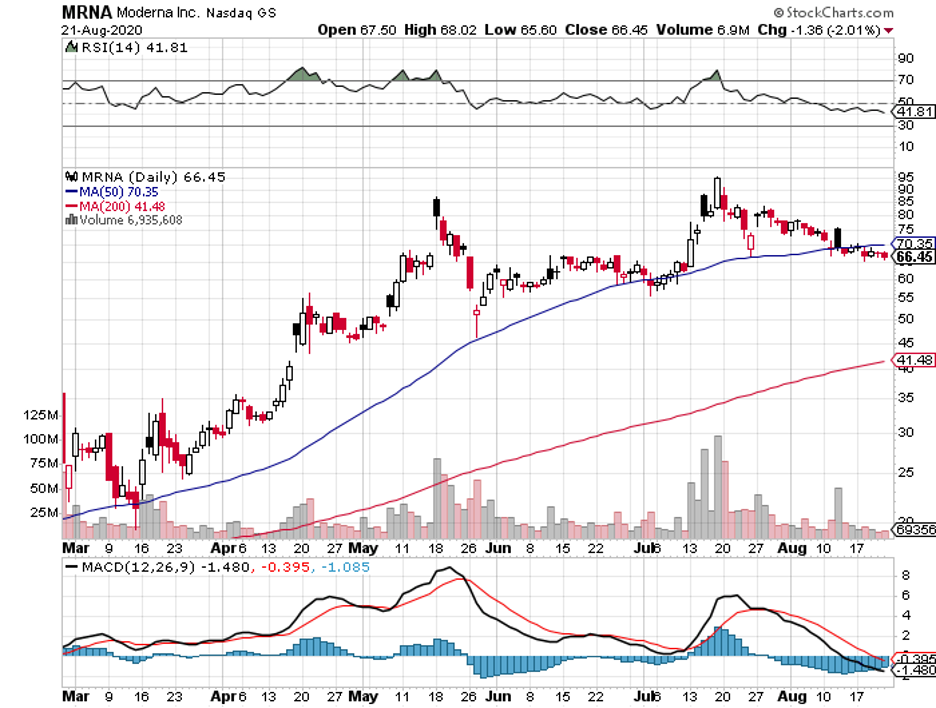

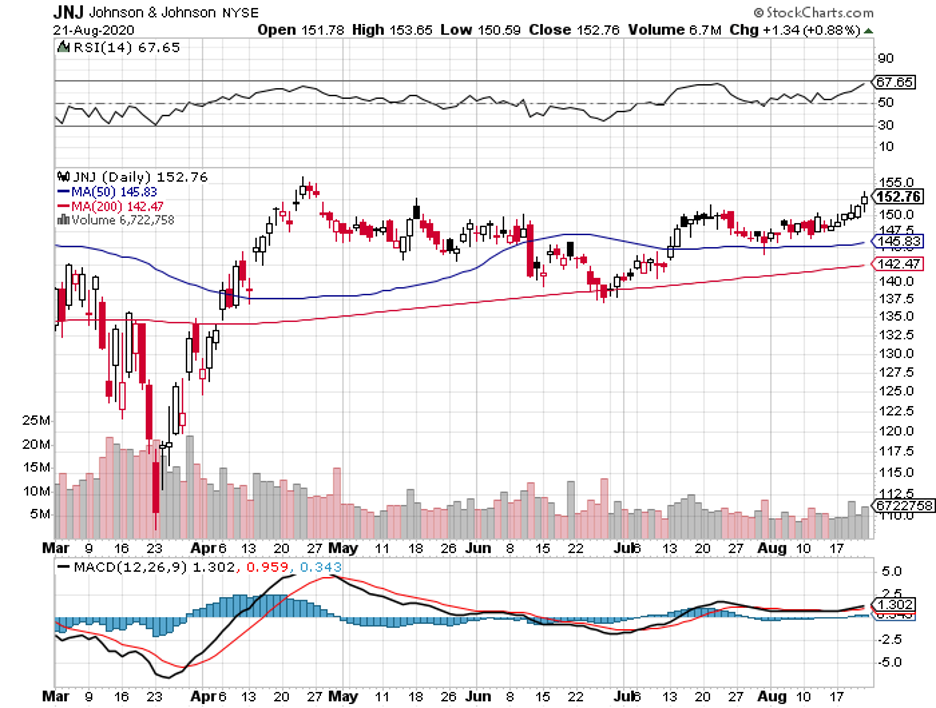
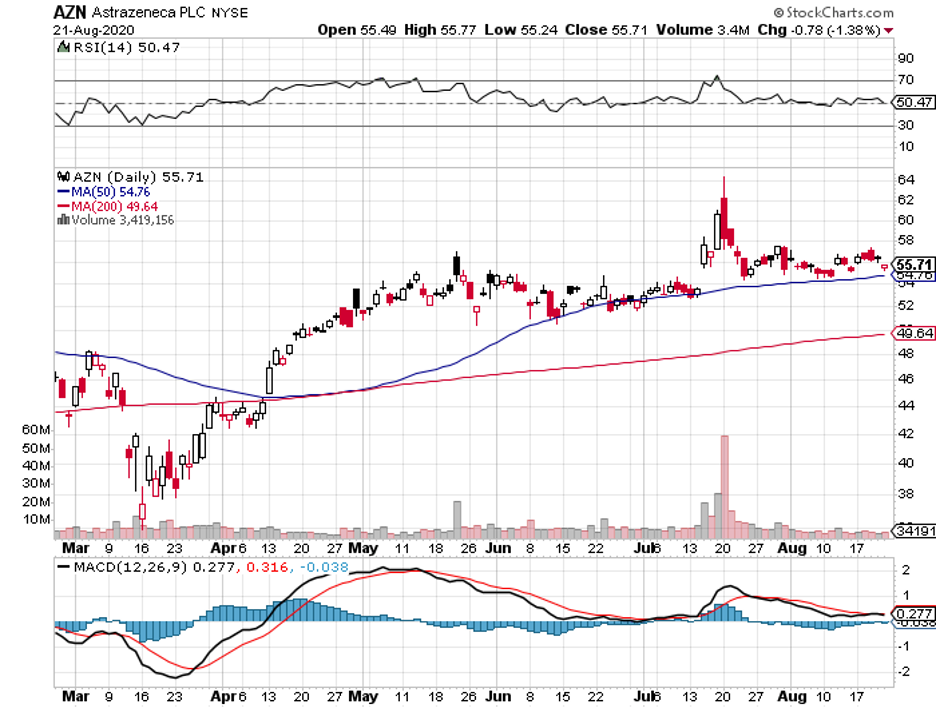
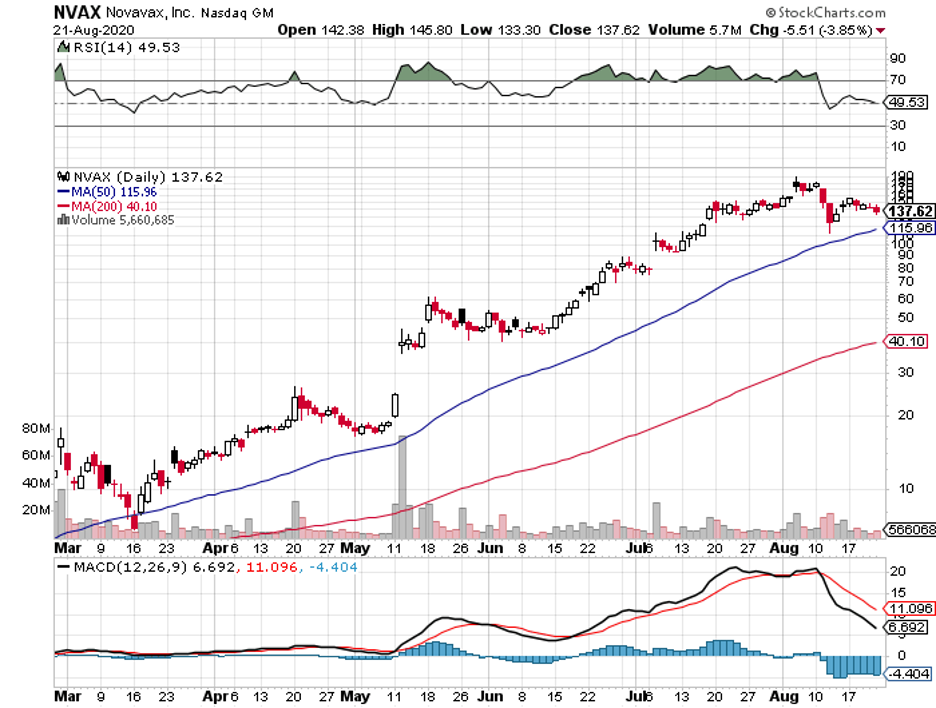
Mad Hedge Biotech & Healthcare Letter
August 18, 2020
Fiat Lux
Featured Trade:
(MORE DARK HORSES IN THE COVID-19 VACCINE RACE)
(CVAC), (MRNA), (BNTX), (PFE), (GSK), (AZN), (JNJ), (NVAX)

Mad Hedge Biotech & Healthcare Letter
July 21, 2020
Fiat Lux
Featured Trade:
(WHY PFIZER AND BIONTECH ARE NOW VACCINE FRONTRUNNERS)
(PFE), (MRNA), (BNTX), (NVAX), (MY), (RHHBY), (SNY)
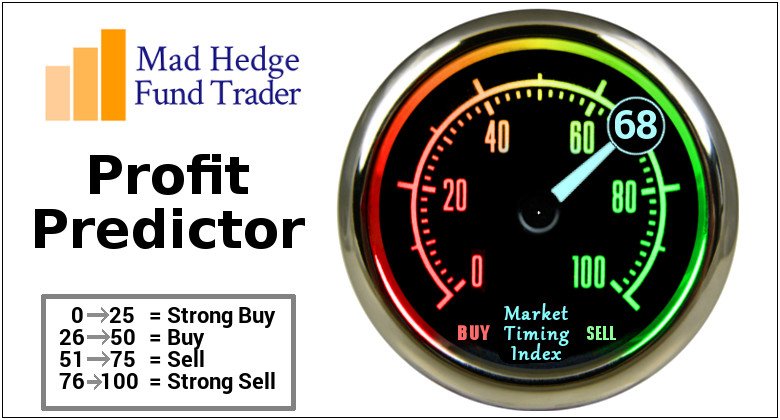
Pfizer (PFE) and BioNTech (BNTX) have stealthily positioned themselves as the new leaders in the COVID-19 vaccine race.
They recently received an FDA fast-track label for BNT162, pushing the timeline for their vaccine candidate to start late-stage trials for 30,000 patients this July as well — a timeline similar to Moderna’s plans.
Like Moderna’s vaccine candidate, Pfizer and BioNTech also use mRNA technology.
Basically, this system takes advantage of our own biological building block to trigger our body to create proteins. These can then help us protect ourselves from pathogens such as the coronavirus.
The announcement of the FDA fast-track pushed Pfizer stock to immediately jump by 5%, an impressive leap for a company with almost $200 billion in market capitalization. Meanwhile, BioNTech stock rose by 15%.
While the vaccine is anticipated to be launched by December 2020, Pfizer executives appear to be more bullish on the timeline.
In fact, the company expects a release date for the late-stage trial data to be available by September with a potential FDA approval by October.
If Pfizer’s vaccine candidate does manage to pass muster, then the two companies are expected to manufacture almost 100 million doses by the end of the year, with the number reaching 1.2 billion by December 2021.
Other than BNT162, Pfizer and BioNTech also received FDA fast track designations for two of the most advanced candidates in their pipeline, BNT162b1 and BNT162b2.
Having all these vaccine candidates under FDA fast track reviews is a welcome reprieve in this ongoing pandemic.
To say that we need an effective vaccine now more than ever is an understatement. This health crisis has been pushing not only the US but also the entire world on the brink of a financial shutdown.
So far, we have recorded over 13 million cases globally—3.5 million of those come from the US alone. With the increasing number of cases, more and more hospitals are crying out for help because they’re getting overburdened.
Apart from its coronavirus program, Pfizer offers a plethora of opportunities for investors.
In 2019, the company raked in $51.8 billion in revenue.
For this year, Pfizer has been zeroing in on improving its pipeline with eight potential blockbuster products anticipated to generate an additional $1 billion or more in annual sales.
Outside its own pipeline, Pfizer is also expected to reap the rewards from its spinoff Upjohn and the merger of this particular unit with Mylan (MYL).
The new company, called Viatris, will inherit some previous blockbusters from Pfizer.
This move is aimed to pave the way for Pfizer to focus on its rising stars like blood clot treatment Eliquis and heart failure medication Vyndaqel. Overall, these changes are projected to provide a bigger impact on Pfizer’s growth.
Meanwhile, BioNTech is also an interesting company to check out.
As with any typical biotechnology stock with no product out in the market yet, BioNTech remains speculative despite its $17.83 billion market capitalization.
However, its involvement with Pfizer in the development of a COVID-19 vaccine will definitely light a fire under this German company.
With that in mind, BioNTech shouldn’t be considered a one-trick pony.
Prior to its work with Pfizer, the company has been focused on creating individualized cancer treatments. So far, it has 10 cancer drug candidates in the 11 clinical trials underway.
Aside from Pfizer, BioNTech has also been working on other biotechnology and healthcare bigwigs like Sanofi (SNY) and Roche (RHHBY).
The race to complete the Phase 3 of the late-stage clinical trials for the COVID-19 vaccine has been tight.
Initially, it was only Moderna that held the top spot—and the stock definitely flourished because of it. Since the pandemic broke out, this biotechnology company’s stock skyrocketed to a jaw-dropping 202% year to date.
At the time, the close second was another small biotechnology with a market capitalization of $6.44 billion, Novavax (NVAX). The company’s stock also soared by a whopping 252.1% thanks to its COVID-19 efforts.
Now, Pfizer and BioNTech are well on their way to dethroning Moderna—if they haven’t done so already.
With a market capitalization of $198.42 billion compared to Moderna’s $31.9 billion, Pfizer has the upper hand in terms of resources, more extensive access to manufacturing partners, and of course, distribution.
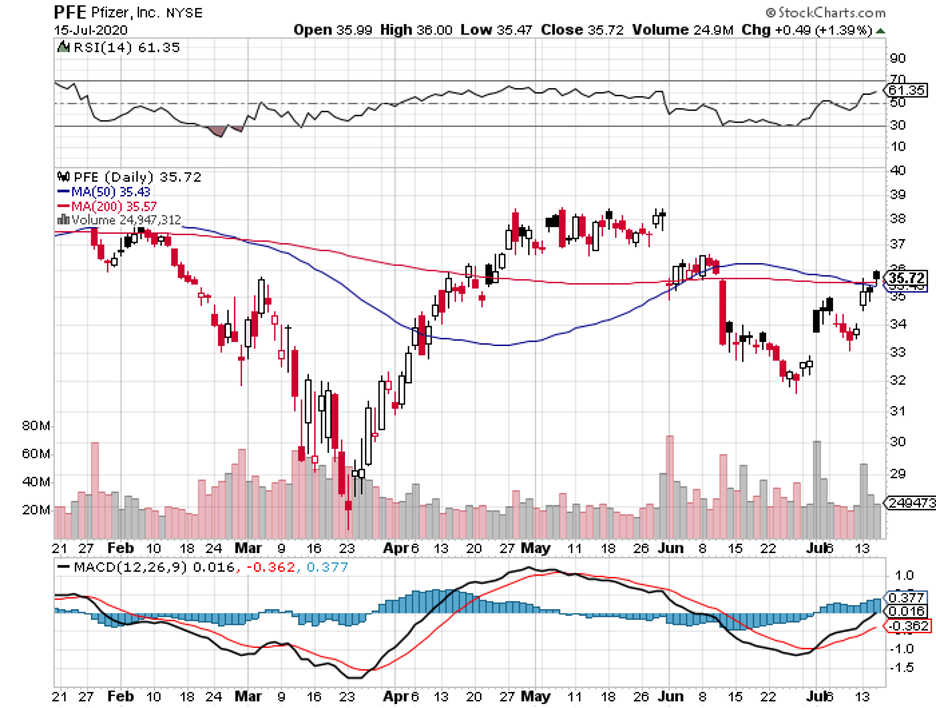
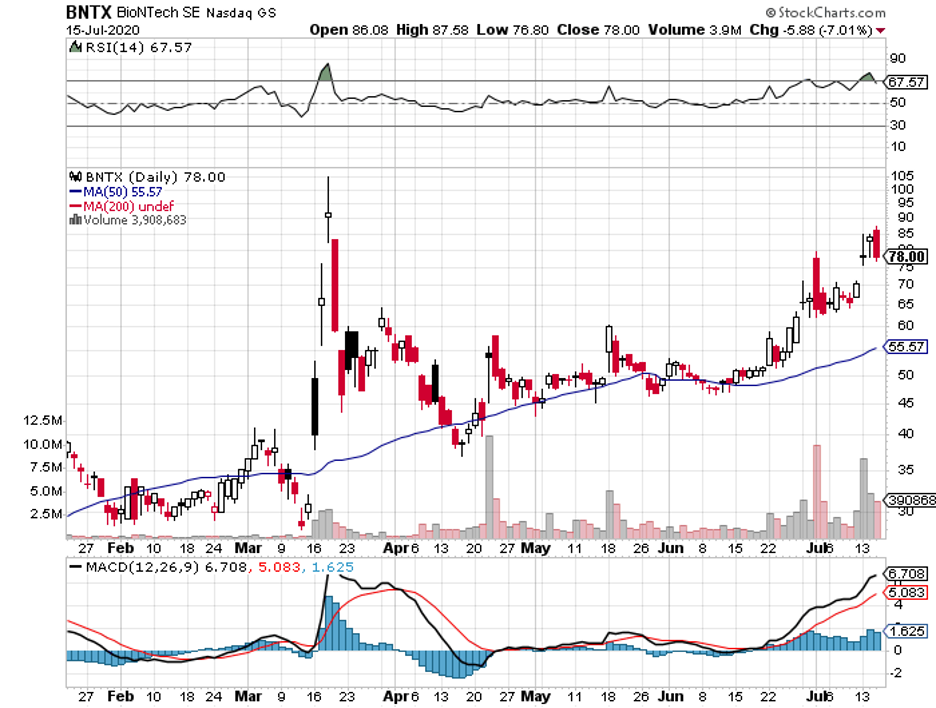
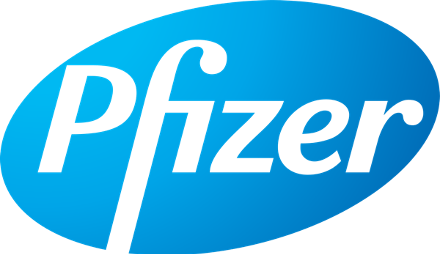
Mad Hedge Biotech & Healthcare Letter
June 30, 2020
Fiat Lux
Featured Trade:
(MODERNA’S BIG CORONA PLAY FOR A SMALL COMPANY)
(MRNA), (INO), (NVAX), (JNJ), (PFE), (BNTX), (LZAGF), (REGN), (AZN), (LLY), (MRK)

Legal Disclaimer
There is a very high degree of risk involved in trading. Past results are not indicative of future returns. MadHedgeFundTrader.com and all individuals affiliated with this site assume no responsibilities for your trading and investment results. The indicators, strategies, columns, articles and all other features are for educational purposes only and should not be construed as investment advice. Information for futures trading observations are obtained from sources believed to be reliable, but we do not warrant its completeness or accuracy, or warrant any results from the use of the information. Your use of the trading observations is entirely at your own risk and it is your sole responsibility to evaluate the accuracy, completeness and usefulness of the information. You must assess the risk of any trade with your broker and make your own independent decisions regarding any securities mentioned herein. Affiliates of MadHedgeFundTrader.com may have a position or effect transactions in the securities described herein (or options thereon) and/or otherwise employ trading strategies that may be consistent or inconsistent with the provided strategies.
This site uses cookies. By continuing to browse the site, you are agreeing to our use of cookies.
OKLearn moreWe may request cookies to be set on your device. We use cookies to let us know when you visit our websites, how you interact with us, to enrich your user experience, and to customize your relationship with our website.
Click on the different category headings to find out more. You can also change some of your preferences. Note that blocking some types of cookies may impact your experience on our websites and the services we are able to offer.
These cookies are strictly necessary to provide you with services available through our website and to use some of its features.
Because these cookies are strictly necessary to deliver the website, refuseing them will have impact how our site functions. You always can block or delete cookies by changing your browser settings and force blocking all cookies on this website. But this will always prompt you to accept/refuse cookies when revisiting our site.
We fully respect if you want to refuse cookies but to avoid asking you again and again kindly allow us to store a cookie for that. You are free to opt out any time or opt in for other cookies to get a better experience. If you refuse cookies we will remove all set cookies in our domain.
We provide you with a list of stored cookies on your computer in our domain so you can check what we stored. Due to security reasons we are not able to show or modify cookies from other domains. You can check these in your browser security settings.
These cookies collect information that is used either in aggregate form to help us understand how our website is being used or how effective our marketing campaigns are, or to help us customize our website and application for you in order to enhance your experience.
If you do not want that we track your visist to our site you can disable tracking in your browser here:
We also use different external services like Google Webfonts, Google Maps, and external Video providers. Since these providers may collect personal data like your IP address we allow you to block them here. Please be aware that this might heavily reduce the functionality and appearance of our site. Changes will take effect once you reload the page.
Google Webfont Settings:
Google Map Settings:
Vimeo and Youtube video embeds:
